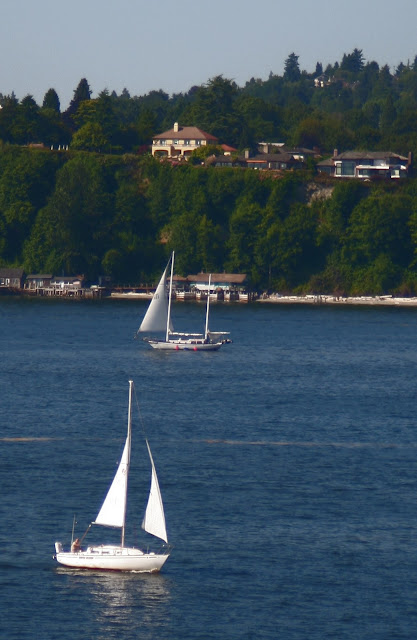In looking for "just the right photo" to introduce these Alaskan blog entries, I looked for one that would give the "look and feel" of much of our cruise. This shot of the Golden Princess cruising inside Tracy Arm Fjord seemed to fit the bill. Obviously not one of my own pics, but it is a very good representation of what Tracy Arm Fjord looked like as we cruised this area for several hours in the early morning hours. So quiet, so serene, with blue icebergs floating all over the fjord.
Before getting to some of the great pics I took on this cruise vacation, here's a little info on our cruise ship accommodations. Since this was a special occassion, we opted for mini-suites instead of just an outside stateroom with a balcony. Our mini-suites (D625 and D631) were located on Deck 9, the
Dolphin Deck of the Golden Princess. Each mini-suite came with twin
beds that made up into a queen-size bed. We also had a separate sitting area with a sofa
bed, desk, two TVs, a refrigerator, walk-in closet, a bathroom with tub/shower,
and, of course, the balcony. All in all, over 320-sq/ft,
including the balcony.
This seven-night cruise included spectacular scenic cruising at sea and a number of quaint, interesting ports of call, including: Ketchikan, famous for totems, fishing, marine
wildlife, and calving glaciers while cruising Tracy Arm Fjord; the capital city
of Juneau, with its scenic and historical treasures; Skagway, with its rich
history of Alaska’s thrilling gold rush days, and home of the famous White Pass Railroad; and the very charming community of Victoria BC, home to the famous
Butchart Gardens. We departed Seattle at 4pm on Sunday afternoon, July 7th; here’s our
itinerary as supplied by the cruise line:
Sunday, July 7th -- Depart Seattle 4:00pm [Mileage to Ketchikan 646 nautical miles]
Monday, July 8th -- Cruising at sea
Tuesday, July 9th -- Arrive Ketchikan 6:30am; Depart 4:00pm [274 nm to Juneau]
Wednesday, July 10th -- Arrive Tracy Arm Fjord for cruising 6:00am, depart 10:00am
Wesnesday, July 10th -- Arrive Juneau 2:00pm, depart 10:00pm [94 nm to Skagway]
Wesnesday, July 10th -- Arrive Juneau 2:00pm, depart 10:00pm [94 nm to Skagway]
Thursday, July 11th -- Arrive Skagway 6:00am, depart 5:00pm (880 nm to Victoria BCC)
Friday, July 12th -- Cruising at sea
Saturday, July 13th -- Arrive Victoria BC 7:00pm, depart at midnight [76.5 nm to Seattle]
Sunday, July 14th -- Arrive Seattle 6:30amTotal distance traveled: 1970.5 nautical miles (2267.6 miles)
Lynette posing between her parents, Glenn & Glenna, with Seattle's skyline in the background.
Here's two more views of Seattle's skyline that I captured as we were leaving the port area and headed into the waters of Puget Sound.
View of Seattle's skyline as we steamed out of Elliot Bay. The commercial fishing vessel, Northern Leader (Kodiak, AK), is in the foreground. This ship was just loitering in the harbor area, waiting for our cruise ship to leave the docks. Believe the Northern Leader is very similar to the type of fishing boats seen on the Discovery Channel's very successful Deadliest Catch TV program. The Golden Princess headed north through Admiralty Inlet and then entered the Strait of Juan de Fuca. The cruise ship continued on a northwesterly course with Vancouver Island about 14 nautical miles off its starboard side on the way to our first port of call in Ketchikan.
Here's a couple views of the ship, just after we boarded. The second one is a shot of The Sanctuary, the Golden Princess' adults-only, spa-inspired deck area/night club with its own swimming pool.
Glenna, Lynette and Glenn checking out the ship as we cruise out of Seattle.
View of a Seattle yacht harbor as we sail north towards the Strait of Juan de Fuca.
Sailboats dotted Puget Sound as we left Seattle.
Looking north toward more of Puget Sound.
This sailboard came along-side us and the occupants were waving wildly to all the cruise ship passengers -- who, in turn, eagerly returned their waves!
A close up of the occupants of the sailboat in the previous photo.
What beautiful scenery and sights as we sailed further north into Puget Sound's waters.
Another view of Seattle's northern metro area. Lynette's Aunt Judy has a condo in that building just to the right of the sailboats docked (left). We've visited Judy at this condo last year and I can tell you that she has absolutely spectacular views of Puget Sound and the shipping/boating traffic.
So, that's our departure from Seattle aboard the Golden Princess. The rest of the evening and all of tomorrow we were at sea, cruising up the rest of Puget Sound, out the Strait of Juan de Fuca -- with the north coast of Washington State on our port side and Vancouver Island on our starboard side -- and then paralleling the seaboard side of Alaska's Inside Passage as we cruised north. Next stop: Ketchikan.







































































.jpg)


















